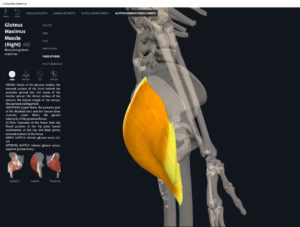Anatomy & Physiology: Muscles—Gluteus Maximus.
Structure.
- Origin: outer ilium, posterior side of sacrum and coccyx, and part of the sacrotuberous and posterior sacroiliac ligament.
- Insertion: gluteal tuberosity (lateral linea aspera) of the femur and iliotibial tract of fascia lata.
Function.
- Concentric action: accelerates hip extension and external/lateral rotation. Upper 1/3 abduct thigh at hip joint; lower 2/3 adduct thigh at hip joint.
- Reverse mover action: posterior tilt and contralateral rotation of pelvis.
- Eccentric action: decelerates hip flexion and internal rotation, tibial internal rotation via iliotibial band.
- Isometric action: stabilization of lumbo-pelvic hip complex.
- Innervation: inferior gluteal nerve.
- Arterial supply: superior gluteal artery and inferior gluteal artery.
Clinical Significance.
More.
- https://www.anatomynext.com/gluteus-maximus/
- https://www.youtube.com/watch?v=aJdNQTO1u1U
- https://www.youtube.com/watch?v=tA-goIvoAcw
- https://www.youtube.com/watch?v=WHDdm0Yxh-o
References
Biel, A. (2015). Trail guide to the body: A hands-on guide to locating muscles, bones and more.
Clark, M., Lucett, S., Sutton, B. G., & National Academy of Sports Medicine. (2014). NASM essentials of corrective exercise training. Burlington, MA: Jones & Bartlett Learning.
Jenkins, G., & Tortora, G. J. (2012). Anatomy and Physiology: From Science to Life, 3rd Edition International Stu. John Wiley & Sons.
Muscolino, J. E. (2017). The muscular system manual: The skeletal muscles of the human body.



